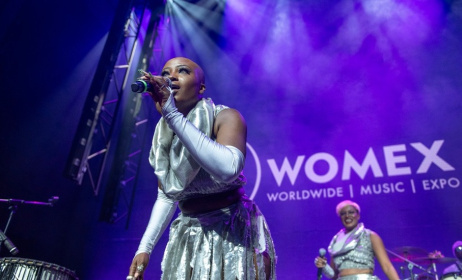IOMMA 2018: Festivals call for ease on artist movement
The Indian Ocean Music Market (IOMMA) marked its seventh edition between 28 and 31 May with a host of artists congregating in Saint-Pierre, Reunion Island. Conceived as a meeting point between artists and music professionals, this year's edition featured 28 music groups selected by an independent jury and some 300 registered professionals, including festival directors.
 Reunion Island artist Kaloune stole the show during the IOMMA showcases last week.
Reunion Island artist Kaloune stole the show during the IOMMA showcases last week.
While there was an element of music business through one-on-one networking sessions and panel discussions, the showcase programming was a great component offering delegates a chance to experience the local music scene as well as music from around the world.
IOMMA opened with showcases by outstanding up-and-coming acts from Reunion at the Stella Matutina Museum in the west of the island. Kaloune stole the show on opening night with her sensibility and passion for words through rich and intimate art made of electro beats and poetry. The other act on the night was Dolores, whose music taps into traditional Creole, Celtic and Caribbean sounds.
But it was Lindigo, an eight-piece band that has been together for the past 19 years, that thrilled the audience at Theatre Luc Donat. The band, led by Olivier Araste, aims at having Reunion’s popular culture recognised worldwide.
“We are a family, we like making music together. We are brought together first and foremost by our passion but we treat it as a job too,” Araste said.
The band's incredible energy and passion can be seen through the members' interaction with the crowd. The band performs a style of maloya, one of the two major music genres of Réunion usually sung in Réunion Creole and traditionally accompanied by percussion and a musical bow.
Commenting on the troubled past of maloya (the style was considered such a threat to the French state that in the 1970s it was banned), Araste said: “We speak about this era as much as possible but we also take the drama out of it. It's necessary to forge ahead. Since coming together as a band, our goal has been to make maloya known and we remain true to our cause of promoting this genre worldwide.”
Having released a new album, Komsa Gayar, at the end of 2017, Olivier says that like elsewhere in the world, the recording industry of Reunion Island has declined. But he says Lindigo still racks up noteworthy album sales.
Currently, Lindigo have their eyes set on other markets. On Komsa Gayar the band collaborated with a legendary rumba group from Cuba. “With new projects we always tour to promote our work. We collaborated with Los Munequitos de Matanzas of Cuba. In the meantime, Pachibaba, accompanied by Cyril Atef and Fixi the accordionist, are other artists whom we're working on a new album with.”
Touring networks
While the showcases kept the delegates on their feet, at Cinema Le Rex serious discussions about touring networks and the opportunities for artists gave festival owners, organisers and bookers much to think about.
Speaking during a panel titled Touring Networks: Myths and Realities, South Africa's Sipho Sithole lamented the imbalances that exist for artists in terms of requirements to travel between African countries. While artists and professionals from Europe have ease of movement, the same cannot be said of those from Africa and Asia. Coincidently, the night before the session was held, a musician from India had to return to Mauritius to obtain a visa that would allow her to enter Reunion, even though she held a Schengen visa.
A panel consisting of Brad Holmes (Bassline Fest), Jean Jacques Toux (Vieilles Charrues Festival), Francois Figureau (Affaires Culturelles Ville de St Hilaire de Riez) and Eric Juret (IOMMA) then attempted to debunk the myths surrounding festival networks.
Some of the conclusions reached were that festival bookers take risks in believing that their programming will attract bigger audiences. As such, programming must speak to both artists and fans. In addition, the festival organisers believe that artists performing as part of festival circuits such as IGODA, which includes six to seven festivals in southern Africa, should be booked for at least two dates, and that partners should look at band size, booking fees and brand positioning when confirming acts.
With festival networks opening up new markets for artists, Sauti za Busara's Yusuf Mahmoud said it was important to grow north-south cooperation by building festival staff capacity. This, he said, could be done by the exchange of festival crew as a way for them to learn about different cultures and the broader market.
Other panels at the market focused on discovering new territories such as Mongolia, Malaysia and Japan, the digitisation in music, monitoring airplay, and new methods of distribution.
After four days of networking, panels and showcases, IOMMA came to an end. The 15th edition of Sakifo festival then took centre stage on the island and featured an eclectic line-up of artists from Australia, South Africa, Kenya, Madagascar, Mozambique and Reunion.





















Commentaires
s'identifier or register to post comments